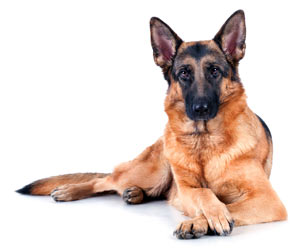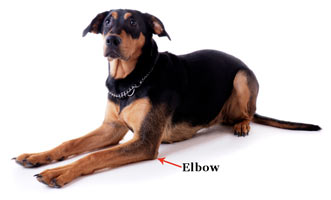Elbow Dysplasia in Dogs

Does your dog have an abnormal walk or a limp in one or both of its front legs? Many things can cause these symptoms and one is elbow dysplasia. The elbow is the area where the humerus, the ulna, and the radius bones meet. Elbow dysplasia occurs when there is an abnormality in the formation of the elbow joint. This can happen in three main ways:
- Ununited anconeal process
- Fragmented medial coronoid process of the ulna
- Osteochondritis dessicans of the medial aspect of the humeral condyle
No matter the cause of the elbow dysplasia, it is a difficult disease to treat and can lead to long- term arthritis.
Breeds, Gender, and Age of Dogs Most Commonly Affected by Elbow Dysplasia

- German Shepherds, Labs, and Rottweilers are diagnosed with elbow dysplasia more frequently than other dog breeds.
- Male dogs are also known to be more affected than females, most likely due to their increased size.
- It should also be noted that some of the causes of elbow dysplasia tend to present most often in very young dogs (under 1-year).
Presentation and Signs of Elbow Dysplasia
- Not all dogs with elbow dysplasia will have signs. Those that do tend to differ in severity.
- Pain: Pain can sometimes be difficult to gauge in animals, as they don't always cry out or show otherwise overt signs.
- Decreased range of motion: The leg is not able to flex or extend to its normal degree.
- Swelling: The tissue surrounding the elbow joint may be enlarged.
- Crepitus: Crackling sounds associated with movement of the elbow, caused by secondary arthritis.
Causes of Elbow Dysplasia
The exact cause of elbow dysplasia has never been identified.
Diagnosis of Elbow Dysplasia
This disease is diagnosed through a veterinarian's examination and x-rays. However, it is important to know that the amount of disease seen on x-rays often doesn't match up with how much pain the patient seems to be showing. A dog may have very serious-looking lesions on the x-ray but be able to walk almost normally. A CT scan may be necessary to confirm the diagnosis of certain causes of dysplasia, especially in the case of medial fragmented coronoid process.
Treatment of Elbow Dysplasia
While there is no cure or surgery that always works to repair this condition, there are many medical treatments possible to help dogs with most forms of elbow dysplasia be more comfortable. The sooner that you treat elbow dysplasia, the better the chance for good results. The surgery is very different for each one of these three issues, but the medical management is very similar.
Non-steroidal Anti-inflammatory Drugs (NSAIDs) like Rimadyl and Deramaxx are very helpful in fighting the pain and inflammation associated with elbow dysplasia. Note: Never give your dog any prescription or over-the-counter medications without first discussing with your veterinarian.
Adequan is a polysulfated glycosaminoglycan that can repair cartilage and lubricate joints. It is good option to help reduce pain if it is in your budget. This drug is much safer for long term use than NSAIDs, but does cost more and is given via an injection by a veterinarian. The specific way this drug works has not been fully explained but studies have shown success in its treatment of elbow dysplasia.
Surgery, in many cases, works well if elbow dysplasia is caught early but owners should be aware that any component of arthritis that is already in the elbow joint will continue to cause the dog pain, even after surgery.
The treatment choice is made on an individual case basis. Factors like the cause of the dysplasia, the age, size, and energy level of dog, and any other complicating conditions that are present should be discussed with your veterinarian as soon as the dog is diagnosed with dysplasia. If you decide with your veterinarian that surgery is the best step for your dog, it is recommend to have it done by a board certified veterinary orthopedic surgeon who is able to do arthroscopic surgery.
Prevention of Elbow Dysplasia
- Because there is a large genetic component to this disease, the best way to decrease elbow dysplasia in the dog population is by requiring breeders to use good practices. There is a certification process that breeders can have done to guarantee their dogs' orthopedic health. The breeding parents and the dog itself can be checked for this and other orthopedic conditions through a grading system. If you are buying a dog from a breeder, be sure to ask for proof that this certification has been done.
- If you adopt a dog rather than using a breeder, being sure to feed a high quality diet and keeping your pet at a healthy weight are the best things you can do to help decrease the risk of joint problems.
- Feeding large breed dogs specially designed large breed puppy food for a full year is important. This will ensure that the dog has the proper nutrient components needed to help with proper orthopedic development.
Prognosis of Elbow Dysplasia
- The outlook for this condition is good if surgical intervention is done early, before arthritis sets in.
- With only medical treatment, dogs with elbow dysplasia will develop progressive arthritis in the elbow joint and may no longer be good candidates for surgery.
- It is also important to remember that, regardless of the cause of the elbow dysplasia, there is a good chance that it will affect both front legs.
Alternative Therapies for Elbow Dysplasia
There is no harm and some good evidence that giving glucosamine* and chondroitin sulfate supplementation as directed by your veterinarian may slow the progression of the arthritis associated with elbow dysplasia. Omega 3 fatty acids* have also been used as a nutritional supplement that may benefit these dogs. These medications may help prevent ongoing damage to the joint and also decrease pain and swelling.
If you are feeding your large breed growing puppy a homemade diet, it is very important to monitor mineral amounts in the food. For example, you do not want to give these dogs too much calcium. If you decide to feed a homemade diet, it is critical to use one developed by a veterinary nutritionist.
Notes:
*Glucosamine supplements should be in the form of glucosamine hydrochloride (HCl), not glucosamine sulfate as glucosamine HCl has better bioavailability.
*Omega 3 fatty acids should be in the form of fish or krill oils, not flaxseed. Fish and krill oils provide the correct forms of anti-inflammatory omega 3s, whereas flaxseed requires conversion to the anti-inflammatory compounds and dogs have limited amounts of the enzyme required to make this conversion.
References
- Cahn, C. L. (2010). The Merck Veterinary Manual. John Wiley and Sons.
- Tilley LP, S. F. (2011). The Five-Minute Veterinary Consult: Canine and Feline. Wiley and Sons.
You May Also Like These Articles:
Causes of Lameness in Dogs: An Overview
Anterior Cruciate Ligament (ACL) Injury in Dogs
Medial Fragmented Coronoid Process
Osteochondritis Dessicans of the Humeral Condyle (OCD)
Panosteitis in Dogs: Growing Pains
Disclaimer: This website is not intended to replace professional consultation, diagnosis, or treatment by a licensed veterinarian. If you require any veterinary related advice, contact your veterinarian promptly. Information at DogHealth.com is exclusively of a general reference nature. Do not disregard veterinary advice or delay treatment as a result of accessing information at this site. Just Answer is an external service not affiliated with DogHealth.com.
Notice: Ask-a-Vet is an affiliated service for those who wish to speak with a veterinary professional about their pet's specific condition. Initially, a bot will ask questions to determine the general nature of your concern. Then, you will be transferred to a human. There is a charge for the service if you choose to connect to a veterinarian. Ask-a-Vet is not manned by the staff or owners of DogHealth.com, and the advice given should not delay or replace a visit to your veterinarian.


